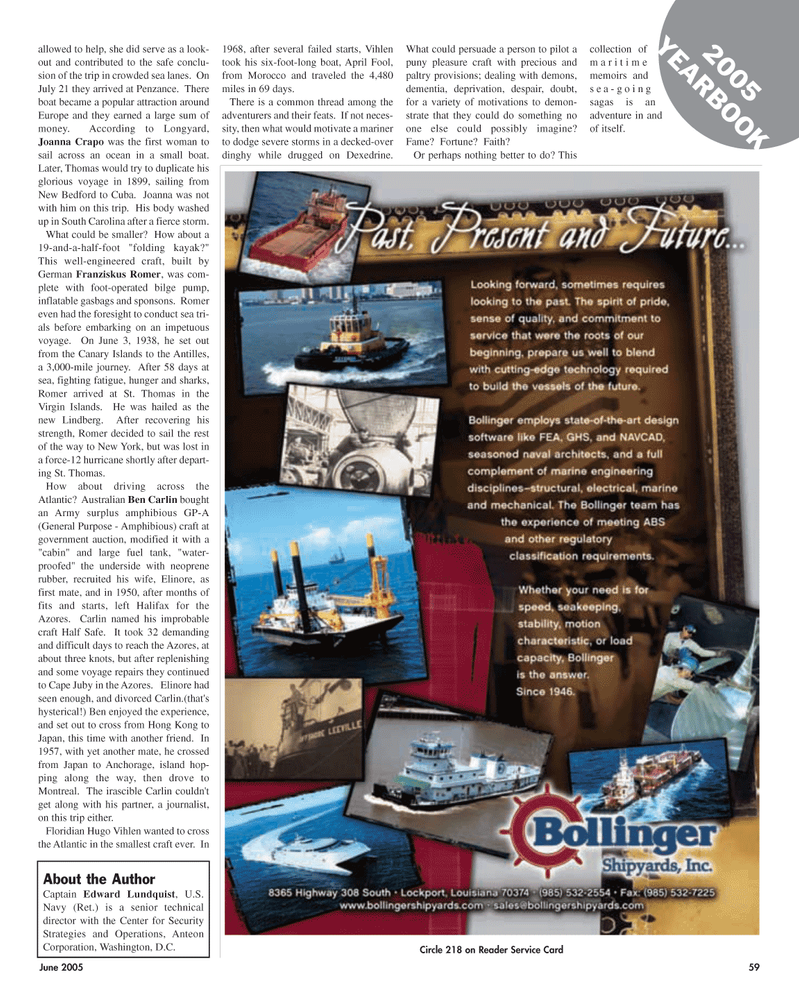
Page 59: of Maritime Reporter Magazine (June 2005)
Annual World Yearbook
Read this page in Pdf, Flash or Html5 edition of June 2005 Maritime Reporter Magazine
June 2005 59 allowed to help, she did serve as a look- out and contributed to the safe conclu- sion of the trip in crowded sea lanes. On
July 21 they arrived at Penzance. There boat became a popular attraction around
Europe and they earned a large sum of money. According to Longyard,
Joanna Crapo was the first woman to sail across an ocean in a small boat.
Later, Thomas would try to duplicate his glorious voyage in 1899, sailing from
New Bedford to Cuba. Joanna was not with him on this trip. His body washed up in South Carolina after a fierce storm.
What could be smaller? How about a 19-and-a-half-foot "folding kayak?"
This well-engineered craft, built by
German Franziskus Romer, was com- plete with foot-operated bilge pump, inflatable gasbags and sponsons. Romer even had the foresight to conduct sea tri- als before embarking on an impetuous voyage. On June 3, 1938, he set out from the Canary Islands to the Antilles, a 3,000-mile journey. After 58 days at sea, fighting fatigue, hunger and sharks,
Romer arrived at St. Thomas in the
Virgin Islands. He was hailed as the new Lindberg. After recovering his strength, Romer decided to sail the rest of the way to New York, but was lost in a force-12 hurricane shortly after depart- ing St. Thomas.
How about driving across the
Atlantic? Australian Ben Carlin bought an Army surplus amphibious GP-A (General Purpose - Amphibious) craft at government auction, modified it with a "cabin" and large fuel tank, "water- proofed" the underside with neoprene rubber, recruited his wife, Elinore, as first mate, and in 1950, after months of fits and starts, left Halifax for the
Azores. Carlin named his improbable craft Half Safe. It took 32 demanding and difficult days to reach the Azores, at about three knots, but after replenishing and some voyage repairs they continued to Cape Juby in the Azores. Elinore had seen enough, and divorced Carlin.(that's hysterical!) Ben enjoyed the experience, and set out to cross from Hong Kong to
Japan, this time with another friend. In 1957, with yet another mate, he crossed from Japan to Anchorage, island hop- ping along the way, then drove to
Montreal. The irascible Carlin couldn't get along with his partner, a journalist, on this trip either.
Floridian Hugo Vihlen wanted to cross the Atlantic in the smallest craft ever. In 1968, after several failed starts, Vihlen took his six-foot-long boat, April Fool, from Morocco and traveled the 4,480 miles in 69 days.
There is a common thread among the adventurers and their feats. If not neces- sity, then what would motivate a mariner to dodge severe storms in a decked-over dinghy while drugged on Dexedrine.
What could persuade a person to pilot a puny pleasure craft with precious and paltry provisions; dealing with demons, dementia, deprivation, despair, doubt, for a variety of motivations to demon- strate that they could do something no one else could possibly imagine?
Fame? Fortune? Faith?
Or perhaps nothing better to do? This collection of maritime memoirs and sea-going sagas is an adventure in and of itself.
Circle 218 on Reader Service Card 2005
YEARBOOK
About the Author
Captain Edward Lundquist, U.S.
Navy (Ret.) is a senior technical director with the Center for Security
Strategies and Operations, Anteon
Corporation, Washington, D.C.
MR JUNE 2005 #8 (57-64).qxd 6/2/2005 4:08 PM Page 59

 58
58

 60
60
